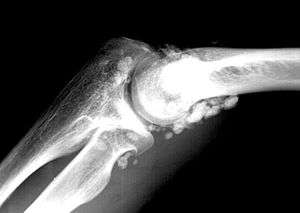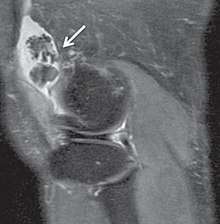Synovial chondromatosis
Synovial chondromatosis is a disease affecting the synovium, a thin flexible membrane around a joint.
| Synovial chondromatosis | |
|---|---|
| Other names | Synovial osteochondromatosis, primary synovial osteochondromatosis, synovial chondrometaplasia, Reichel's syndrome, Reichel-Jones-Henderson syndrome |
 | |
| X-ray of an elbow affected by synovial chondromatosis | |
| Specialty | Orthopedics |
Signs and symptoms
People usually complain of pain in one joint, which persists for months, or even years, does not ease with exercise, steroid injection or heat treatment, shows nothing on X-ray, but shows a definite restriction of movement.
There are 3 defined stages to this disease:
- early: no loose bodies but active synovial disease;
- transitional: active synovial disease, and loose bodies;
- late: loose bodies but no synovial disease;
In the early stages of the disease it is often confused with tendinitis and/or arthritis. Once it reaches transitional the loose bodies become apparent with X-ray in greater than 70% of cases, with MRI often showing where xray fails. In experienced hands, US is also useful for the diagnosis.[1]
In the disease, the thin flexible membrane of the synovium gradually forms blisters which calcify and enlarge. These nodules eventually break free and float around the joint space becoming larger – these add to the discomfort and stiffness of the joint.
The disease is rare and little known and there is currently no known cure. The affected tissue will show up as a semi-solid mass in a MRI scan, final diagnosis is usually confirmed by taking a biopsy.
Synovial chondromatosis occurs twice as commonly in males as females and usually in their forties. However, online communities for synovial chondromatosis patients have yielded a stark contrast, with equal representation from both genders and members diagnosed as young as late teenage/early 20s.
The disease generally affects only one of the larger weight bearing joints (hip, ankle, knee) – although the elbow, and wrist can also be affected. Rarely involves the temporal mandibular joint.[2]
Cause
Diagnosis

Treatment
Treatment is frequently by means of removal of the loose bodies and of a partial or full synovectomy (removal of the synovium)
Full synovectomy is a moderately major operation and involves completely exposing the joint and removing the affected tissue. Partial synovectomy is normally done arthroscopically. Synovectomies are normally carried out by shaving the lining of the knee but there are other ways of achieving this by either freezing the synovium or by the use of radiation treatment.
The need for further procedures is greater than 25% although normally the frequency of the required removal of loose bodies is reduced by the previous synovectomy. There have been documented cases of malignant transformation however this is rare.
Whilst the condition can be described as a ‘benign growth’ it seldom affects more than one joint, and does not usually affect surrounding tissue.
Names
It is also known as Reichel's syndrome or Reichel-Jones-Henderson syndrome, named after Friedrich Paul Reichel, Hugh Toland Jones and Melvin Starkey Henderson.[4]
References
- Arend CF. Ultrasound of the Shoulder. Master Medical Books, 2013. Free chapter on ultrasound findings of synovial chondromatosis affecting the subacromial-subdeltoid bursa available at ShoulderUS.com
- Fuller E, Bharatha A, Yeung R, Kassel EE, Aviv RI, Howard P, Symons SP. Case of the month #166: synovial chondromatosis of the temporal mandibular joint. Canadian Association of Radiologists Journal. 2011 May; 62(2):151-153.
- Lima, Luana T. Barros de; Albuquerque Filho, Eolo Santana de; Batista, Laecio Leitão; Moraes, Talita Peixoto de; Pereira, Bruno Perez Guedes (2016). "Unusual lesions that distend the knee joint: pictorial essay". Radiologia Brasileira. 49 (5): 322–328. doi:10.1590/0100-3984.2015.0154. ISSN 0100-3984. PMC 5094822. (CC BY 4.0)
- http://www.whonamedit.com/synd.cfm/2114.html
External links
| Classification |
|
|---|